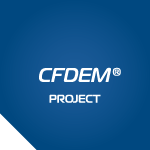DESIgn – Discrete-Element bonded-particle Sea Ice model
Model idea in just a few sentences
Sea ice is composed of floes of various sizes and shapes, moving on the sea surface and interacting with each other due to forces from the ocean and the atmosphere, as well as interactions between individual floes. The large-scale behavior and properties of the ice cover (including the floe-size distribution, FSD) is an emergent property of processes taking place at the floe level. The FSD – a product of numerous floe breaking and refreezing events – has a profound influence on the dynamics of the ice cover, its response to forcing and the way in which stresses are transmitted. In the proposed discrete-element model (DEM), sea ice is represented with two types of objects: disk-shaped "grains" and elastic "bonds". Without bonds (left figure below), ice floes, identical with grains, have a prescribed FSD. With bonds (right figure below), the grains are building-blocks of ice floes that may assume various shapes and sizes due to bond breaking and refreezing, making the FSD one of the results of the simulation. The model is two-dimensional, but it takes into account some wave-induced effects related to the curvature of the water surface. Other implemented forces are the Coriolis force, and the wind- and current-indiced skin and form drag; additional forcing types can be implemented in a straightforward manner.

Model implementation
DESIgn is based on LAMMPS and LIGGGHTS:
 www.lammps.sandia.gov
www.lammps.sandia.gov
 www.cfdem.com
www.cfdem.com
It is implemented as a toolbox of LIGGGHTS, an open-source DEM model, and fully uses its functionalities. Its code is written in compliance with LIGGGHTS standards and "philosophy", making it, on the one hand, easily transferable to new LIGGGHTS versions, and on the other hand, extendable with new features. The forcing types and utilities implemented in DESIgn make it easy to configure and run the model for many typical situations – like those described in the publications listed below – but the possible range of applications of the model is incomparably wider.
For details, and for full possibilities and limitations of the model, see the User's Guide and the papers cited below.
Possible applications
… include, but are not limited to the analysis of:
- processes leading to the formation of clusters of ice floes on the sea surface
- properties of contact and force networks in sea ice under various conditions (convergence, shear deformation, wind forcing, etc.)
- aspects of the dynamics of the marginal ice zone
- jamming, long-range transmission of stress, and other processes related to deformation of ice at high ice concentration
- influence of the FSD on the properties and behavior of the ice cover
- ice breaking and floe formation in various conditions (shear deformation of a compact ice pack; bending and twisting moments due to surface waves propagating through the ice)
- the role of breaking and refreezing events in shaping the FSD
- …
Publications:
Herman, A., 2016. Discrete-Element bonded-particle Sea Ice model DESIgn, version 1.3a – model description and implementation. Geosci. Model Dev., 9, 1219-1241, doi:10.5194/gmd-9-1219-2016. (paper)
–
the main paper presenting the model, with a full set of equations and the theoretical background.
Herman, A., 2013. Numerical modeling of force and contact networks in fragmented sea ice.
Annals Glaciology, 54, 114-120, doi:10.3189/2013AoG62A055.
(paper)
Herman, A., 2013. Shear-jamming in two-dimensional granular materials with power-law grain-size distribution.
Entropy, 15, 4802-4821, doi:10.3390/e15114802.
(paper)
–
papers presenting results obtained with a previous, LAMMPS-based version of the model, without bonds.
My older papers on granular sea ice modeling (based on a still simpler model, called Small Floe Collider):
Herman, A., 2012. Influence of ice concentration and floe-size distribution on cluster formation in sea ice floes.
Cent. Europ. J. Phys., 10, 715-722, doi:10.2478/s11534-012-0071-6.
(paper)
Herman, A., 2011. Molecular-dynamics simulation of clustering processes in sea-ice floes.
Phys. Rev. E, 84, 056104, doi:10.1103/PhysRevE.84.056104.
(paper); see also:
manuscript on arXiv and
accompanying Physics Synopsis
Code and documentation
The first published version of DESIgn was 1.3. The most recent version is 1.3a.
A zip file with the code of most recent version of the sea-ice toolbox can be downloaded from here.
The DESIgn version history and previous versions of the code can be found here,
together with a brief information about changes and new features planned for the next release.
Before installing and using DESIgn, it is advisable to read the instructions in the
User's Guide.
The contents of the zip file are:
- doc – documentation, including the pdf with the User's Guide and html documentation of individual commands in the "LIGGGHTS style"
- src – source code of the toolbox
- examples – a few examples of application of the toolbox, with configuration scripts and necessary input files
- utils – some additional Matlab tools for preparing the input and for reading and visualization of the model output
You are allowed to freely use the code or any of its parts. If you publish any results obtained with it, please cite the Herman (2015) paper and provide a link to this page in your publication.
If you have any questions, comments or suggestions related to this model and its further development – including bug reports and sugegstions regarding new features you would like to have in the model – feel free to contact me by email/phone/ResearchGate provided at the top of this page.



 0000-0001-5112-7165
0000-0001-5112-7165



 0000-0001-5112-7165
0000-0001-5112-7165

 www.lammps.sandia.gov
www.lammps.sandia.gov
![]() www.cfdem.com
www.cfdem.com